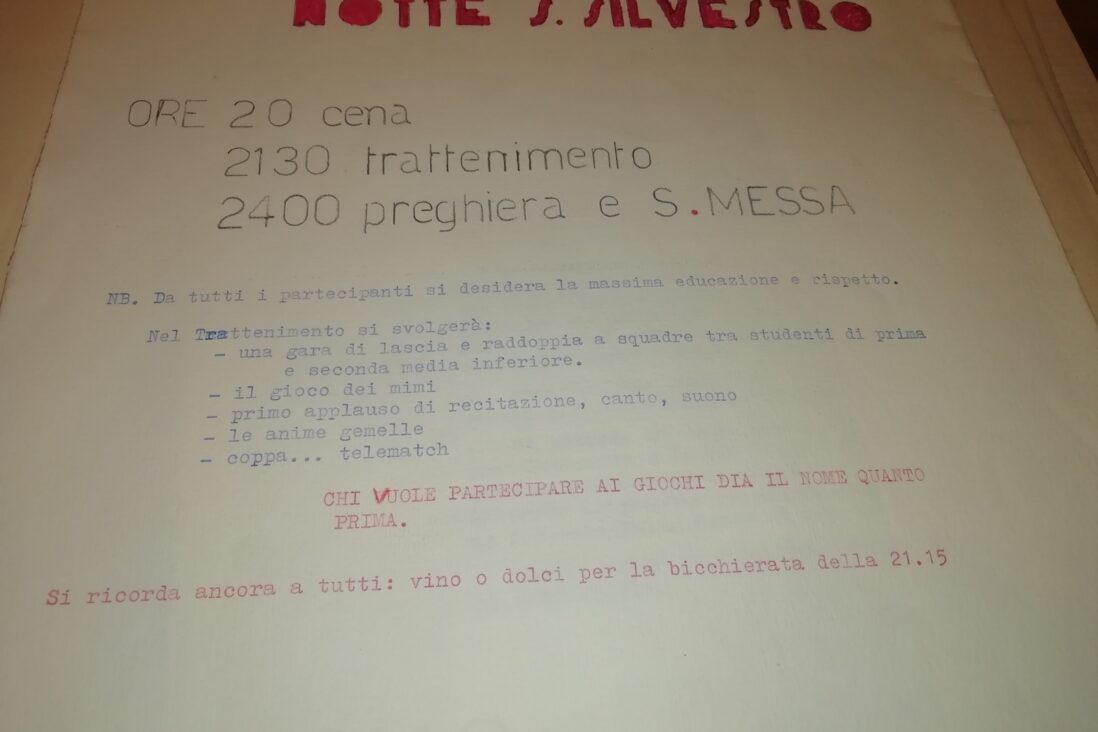New Year’s Eve in Conegliano

As we approach the end of the year, today’s column is dedicated precisely to 31 December, and to do so we open the Conegliano folder and relive the celebrations organised by the Jesuits in the late 1950s.
In 1956, the Veneto-Milan Province of the Society of Jesus purchased the buildings of the former Toniolo College from the Vittorio Veneto Seminary to use them as an apostolic school but above all to house the boys, also providing a canteen service.
We learn this from the dense correspondence of Fr. Bertuletti, who was busy looking for financiers for the student house, as he could only ask for a derisory contribution from his boys, 50 to 100 boys a day were housed here, every day, who were served ‘lunch: dry pasta or in broth, a dish with side dish and bread’.
The apostolic school was intended for the education of boys with an early vocation, in order to nurture them and train them for the novitiate. Most of these boys came from the countryside and their families hoped for a good education.
The Jesuits had decided to welcome these boys to the canteen in the time between morning and afternoon classes, to prevent them from eating in the street and so that they would have a place to eat and study.
It is clear from the correspondence that the fathers were aware that the majority of enrolments were not accompanied by a vocation, yet the pedagogical and Ignatian aim for the formation of the person prevailed, even before the collection of vocations. In this sense, the work that Fr Bertuletti did for the boys is exemplary.
In fact, Fr Bertuletti’s work in requesting funding bore various fruits: from donations from private individuals, to those from the Pontifical Work of Assistance which sent tens of kilos of pasta, flour, milk and cheese; from funding from the National Combatants Association, since among the boys enrolled in the canteen service were also the sons of those who had fought in the Second World War, to help from the ‘Cooperative for American remittances to everywhere’ active after the Second World War.
The Jesuit had the ‘human formation of the child’ very much at heart and decided to also employ a qualified teacher who could assist the children after school and also provide extra tuition.
This Jesuit’s foresight went even further: he decided to organise a New Year’s Eve party for the boys in 1956, and the following year it was the boys themselves who asked the Jesuits to repeat the experience.
From a letter from Fr Bertuletti to the parents:
Dear Parents, having been pleased with the way they spent New Year’s Eve ’56 – ’57 with us, the boys are asking us to organise the entertainment again this year. However. I must introduce a novelty into the programme: dinner.
The reason is this: we want to start the New Year with the possibility of having a nice Holy Communion. We now require three hours of fasting from solid food or alcoholic beverages. In order to be able to celebrate Holy Mass at 0.30 hrs, dinner will be served at 20.00 hrs, ending with a drink. Around 11.30 p.m. tea or coffee will be served.
At midnight we will sing the Te Deum before the Blessed Sacrament, followed by Holy Mass. […] At 10 p.m. family members of the members will also be allowed to participate in the small entertainment of songs, games and jokes. At the end of the service, children who do not have family members of their own or neighbours present will be accompanied home.
Pictured is the ‘playbill’ from the previous New Year’s Eve, with some games taken from the best-known programmes of the time such as ‘Lascia e raddoppia’ or ‘Telematch’.
The correspondence also contains lists of goods and objects purchased in the year the student house was opened and in subsequent years: pasta, chocolates, Galbani, bread, vegetables and fruit, as well as Zoppas naphtha, blankets, Singer, slicer, pots and pans, potato peelers, and also goods deemed necessary for the students: ‘harmonium, piano, encyclopaedia, record player, amplifier, magnetophone, refrigerator’.
The student house experience came to an end in 1960, the building was handed over to the diocese.
We hope that the boys of that time may have taken a trip back to 31 December in the late 1950s.
Maria Macchi











